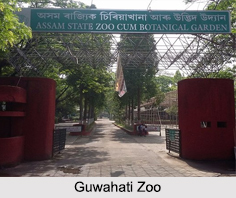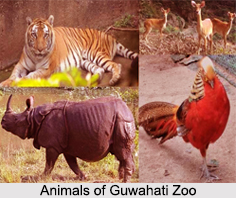 Located within the Hengrabari Reserved Forest, the Guwahati Zoo is also known as the Assam State Zoo cum Botanical Garden. It was established in the year 1957 and was open to the public a year later in 1958. The zoological garden spreads across an area of 175 hectares including the 82 hectares of botanical garden. The Guwahati Zoo is a nodal centre of ex-situ conservation and a host of awareness and outreach activities.
Located within the Hengrabari Reserved Forest, the Guwahati Zoo is also known as the Assam State Zoo cum Botanical Garden. It was established in the year 1957 and was open to the public a year later in 1958. The zoological garden spreads across an area of 175 hectares including the 82 hectares of botanical garden. The Guwahati Zoo is a nodal centre of ex-situ conservation and a host of awareness and outreach activities.
History of Guwahati Zoo
In the year 1957, the 64th session of the Indian National Congress was held in Guwahati in the state of Assam. The organizing committee of the Indian National Congress had organised an exhibit which included few animals and birds. By the end of the meeting, it was decided to build a zoo to house these animals. And thus, the Guwahati Zoo came into existence in 1957 within the Hengrabari Reserved Forest as it provided suitable facilities and amenities for the animals. Initially, the Guwahati Zoo was started with a total number of 42 species of birds and 236 species of animals.
 Flora and Fauna of Guwahati Zoo
Flora and Fauna of Guwahati Zoo
Comprising of a unique diversity of varied flora and fauna, the Guwahati Zoo is currently home to about 895 animals, birds and reptiles representing almost 113 species of animals and birds from around the world. Exotic species of chimpanzees, white and black rhinoceros, zebras, ostriches and giraffes from Africa; puma, jaguar and llama from South America and kangaroos from Australia are found here.
Few of the endemic species found here are the Hoolock Gibbon, One horned Rhino, Golden Langur, Stump tailed Macaque, and Pig tailed Macaque, Slow Loris, Sangai, Clouded Leopard, Golden Cat, Binturong, Mithun, Serow, Brush-tailed Porcupine and Crestless Porcupine among others. Other than animals, there is also a variety of birds like the Cassowary, Silver Pheasant, Parakeets, Steppe Eagle, Hill Myna, and Purple Moorhen, bar headed Geese, White Ibis, Painted Stork, Crane, Macaw and Rosy Pelican.
It is said that owing to its rich fauna, The Guwahati Zoo is popularly known as the "Green Lung" of the Guwahati city. The zoo also facilitates in rescue and rehabilitation of wild animals, nature awareness, interpretation and responsible nature tourism. In 1982, a museum and a botanical garden were added to the zoo and from August 2005, the Animal Adoption Scheme was launched.
Visiting Information on Guwahati Zoo
The Guwahati railway station is the nearest at a distance of 5 km from the zoo and the Lokpriya Gopinath Bordoloi International Airport is closest at a distance of 28 km from the Guwahati Zoo.



















